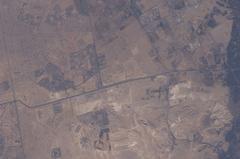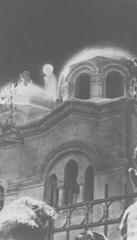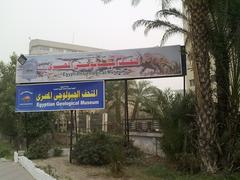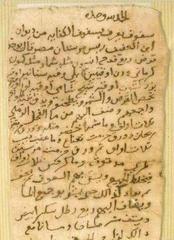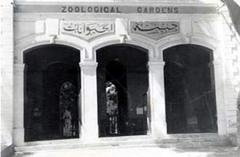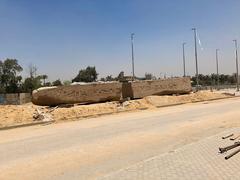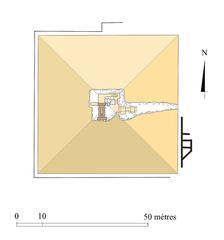
Pyramid G1-B Visiting Hours, Tickets, and Travel Guide – Giza Governorate, Egypt
Date: 04/07/2025
Introduction: Why Visit Pyramid G1-B?
Located on the legendary Giza Plateau, Pyramid G1-B—commonly known as the Pyramid of Queen Meritites I—stands as an enduring symbol of ancient Egypt’s architectural innovation and royal legacy. As one of three “Queen’s Pyramids” neighboring the Great Pyramid of Khufu, G1-B provides a unique perspective on Old Kingdom funerary traditions and the prominent roles of royal women in ancient Egyptian society. Constructed during the Fourth Dynasty (26th century BCE), this subsidiary pyramid offers both historical intrigue and a quieter visitor experience than Giza’s more famous monuments (Hurghada Lovers; travelpander.com).
Modern enhancements to the Giza Plateau—including a new visitor center, eco-friendly transport, and improved accessibility—make visiting G1-B more comfortable and informative than ever. Whether you’re a history enthusiast, an adventurer, or a first-time visitor, this guide covers everything you need to plan your trip, including historical context, architectural highlights, ticketing information, and essential travel tips (Newsweek; Egyptian Streets).
Historical Significance of Pyramid G1-B
Royal Context and Construction
Pyramid G1-B was commissioned during the reign of Pharaoh Khufu, the builder of the Great Pyramid, as a funerary monument for Queen Meritites I, one of his principal wives. The pyramid’s position east of Khufu’s monument reflects the queen’s high status and the importance of royal women in dynastic succession and mortuary rituals. The base rests on elevated limestone bedrock, which provided a stable foundation and emphasized the queen’s proximity to the king, both physically and symbolically (Hurghada Lovers; Rost Architects).
Religious and Cultural Importance
G1-B was intended as a “place of ascension” (MER), enabling the queen’s spirit to join the gods in the afterlife. The mortuary complex and the pyramid’s alignment with celestial bodies underscored the belief in divine kingship and the queen’s eternal transformation into an akh, or blessed spirit (Rost Architects).
Architectural Features
Layout, Dimensions, and Structure
G1-B is centrally located among the three Queen’s Pyramids (G1-a, G1-b, G1-c) on the Great Pyramid’s east side. Its original base measured approximately 49–50 meters, and it rose to about 30 meters before centuries of erosion and stone robbing. The pyramid’s entrance is on the north face, leading via a descending passage to a modest burial chamber. While simpler than the Great Pyramid, G1-B’s interior was originally lined in limestone and may have featured ritual niches (Hurghada Lovers).
Mortuary Complex and Artistic Elements
The pyramid was part of a larger mortuary complex, including an offering chapel to the east, where priests made daily offerings to sustain the queen’s spirit. While little decorative art survives, the funerary chapel and chamber likely displayed reliefs or paintings of the queen with gods, reinforcing religious doctrines of the time (Rost Architects).
Construction Techniques
Builders used locally quarried limestone for the core, with higher-quality Tura limestone for the casing. Construction methods involved ramps, sledges, and skilled labor, reflecting the technical sophistication of the Old Kingdom (Rost Architects).
Archaeological and Historical Importance
Insights into Royal Burial Practices
G1-B’s proximity to Khufu’s pyramid and the other queen’s pyramids illustrates the importance of familial relationships in royal mortuary ideology. The subsidiary pyramids were integral to the king’s funerary landscape, serving as eternal homes for prominent royal women (travelpander.com).
Excavations and Finds
Although heavily robbed in antiquity, archaeological work has recovered fragments of funerary equipment, pottery, and inscribed limestone blocks, shedding light on burial traditions and material culture (whyisfamous.com).
Preservation and Modern Research
Conservation Efforts
Egypt’s Ministry of Antiquities, in partnership with international organizations, continues to protect G1-B from environmental and tourism-related threats. Restoration focuses on structural stabilization and site management (travelpander.com).
Technological Advances
Modern tools—including 3D scanning, drone surveys, and ground-penetrating radar—are enhancing our understanding of the pyramid’s construction and revealing possible hidden features (thearchaeologist.org; egyptindependent.com).
Visiting Pyramid G1-B: Hours, Tickets, and Access
Location and Getting There
Pyramid G1-B is directly east of the Great Pyramid of Khufu, within the Giza Plateau, about 15 km from central Cairo. It’s easily reached by taxi, ride-hailing apps, or organized tours (Egyptian Streets). The new main entrance via the Fayoum Desert Road leads to a modern visitor center with ticketing, information, and orientation services (Newsweek).
Visiting Hours (2025)
- October–March: 8:00 am – 5:00 pm
- April–September: 7:00 am – 7:00 pm
- Ramadan: Reduced hours; check locally
- Last Entry: One hour before closing (Egyptian Streets)
Ticket Information
- General Admission: EGP 600 (~$12 USD) for adults; discounts for students and locals
- Queen’s Pyramid Access: Walking around the exterior is included in general admission. Interior access is typically restricted to protect the site.
- Purchase: Tickets are available at the visitor center or online in advance. Electronic gates accept both printed and digital tickets (Egyptian Streets).
Accessibility
The plateau features paved walkways and ramps to improve accessibility, but the terrain around G1-B remains uneven and sandy. Wheelchair users may find access challenging near the Queen’s Pyramids (Corinthian Travel).
Site Navigation and Visitor Experience
Sustainable Transport
Private vehicles are not permitted on the plateau; visitors use a network of electric buses connecting key sites, including G1-B, the Great Pyramid, and the Sphinx. These buses run frequently and help protect the environment (Newsweek).
Facilities and Amenities
- Visitor Center: Offers maps, restrooms, ATMs, first aid, and guided tour bookings
- Dining: The 9 Pyramids Lounge provides meals and panoramic views
- Shaded Rest Areas: Found along main routes; drinking water stations available
- Official Souvenirs: Sold at the visitor center and designated shops
Guided Tours
Licensed guides can be booked at the visitor center or in advance. Guides offer expert context and can help navigate touts and aggressive vendors (Corinthian Travel).
Independent Exploration
Visitors can approach G1-B’s base and walk around its exterior, observing construction details and the relationship to the Great Pyramid. Climbing on any pyramid is strictly prohibited (Ancient Navigator).
Photography and Media
- Allowed: Photography is permitted in outdoor areas. Use of tripods requires a small fee; drones are not allowed (Travel Hack Fun).
- Best Times: Early morning or late afternoon for optimal lighting and fewer crowds (Travel Hack Fun).
- Visuals: For compelling images, frame G1-B with the Great Pyramid in the background.
Practical Tips
- Dress Modestly: Shoulders and knees covered; lightweight, breathable fabrics recommended (Egypt Mythology).
- Footwear: Sturdy, closed-toe shoes are essential.
- Sun Protection: Bring a hat, sunglasses, and sunscreen.
- Hydration: Carry water; refill at designated stations.
- Cash: Small denominations are useful for tips and minor purchases.
- Vendors: Politely but firmly decline unwanted offers; agree on prices in advance when necessary (Corinthian Travel).
- Security: The area is well-patrolled and monitored.
Ethical and Cultural Considerations
- Respect the Site: Do not climb, deface, or remove stones.
- Photography: Always ask before photographing people.
- Animal Welfare: Camel and horse rides have been relocated away from main monuments; ethical tourism standards are enforced.
Nearby Attractions
- Great Pyramid, Sphinx, and Solar Boat Museum: All easily accessible from G1-B
- Grand Egyptian Museum: Newly opened and accessible via shuttle from the plateau (Newsweek)
Frequently Asked Questions (FAQ)
Q: What are the visiting hours for Pyramid G1-B?
A: From 8:00 am to 5:00 pm (October–March) and 7:00 am to 7:00 pm (April–September). Last entry is usually one hour before closing.
Q: Are tickets required to visit G1-B?
A: General admission includes access to G1-B’s exterior. Interior access is generally not permitted.
Q: Can I enter Pyramid G1-B?
A: The interior is closed to the public to protect the monument.
Q: Is the site accessible for visitors with disabilities?
A: Paved walkways help, but terrain near G1-B may be difficult for wheelchairs.
Q: Are guided tours available?
A: Yes, and highly recommended for context and convenience.
Visuals and Navigation Aids
- Suggested Images: High-resolution photo of G1-B with the Great Pyramid, map of the Queen’s Pyramids, visitor center entrance, infographic on hours and tickets.
- Alt Text Example: “Pyramid G1-B with Great Pyramid in background, Giza Plateau”
Final Recommendations
Plan your visit by booking tickets and guides in advance, especially during peak tourist seasons. Arrive early to enjoy cooler temperatures and better lighting. Respect site rules and local customs to ensure both a rewarding visit and the preservation of Egypt’s ancient treasures.
For the latest updates on hours, tickets, and travel tips, download the Audiala app and follow our social channels.
Summary Table: Key Facts for Visiting Pyramid G1-B
| Feature | Details |
|---|---|
| Location | East of Great Pyramid on Giza Plateau, Giza, Egypt |
| Historical Date | c. 2580–2560 BCE, Fourth Dynasty |
| Original Dimensions | Base: ~49–50 m; Height: ~30 m |
| Visiting Hours | 8:00 am–5:00 pm (Oct–Mar); 7:00 am–7:00 pm (Apr–Sep) |
| Tickets | EGP 600 general admission (adults) |
| Accessibility | Paved paths; uneven/sandy terrain near G1-B |
| Guided Tours | Available at visitor center or in advance |
| Photography | Allowed outdoors; tripods require fee; no drones |
| Restrooms/Food | Visitor center and main stops |
| Nearby Attractions | Great Pyramid, Sphinx, Solar Boat Museum, GEM |
Sources and Further Reading
- Pyramid of Queen Meritites I – Hurghada Lovers
- Age of the Great Pyramid – travelpander.com
- Pyramids, Tourism, and Visitor Experience – Newsweek
- Visiting the Pyramids of Giza – Egyptian Streets
- A Brief History of the Great Pyramid at Giza – Rost Architects
- Pyramid of Giza – whyisfamous.com
- What Researchers Discovered Beneath the Pyramids – thearchaeologist.org
- Significant Archaeological Discovery in the Pyramids Area in 2025 – egyptindependent.com
- How to Visit the Pyramids of Giza – earthtrekkers.com
- Local’s Guide to Visiting Giza – localguidetoegypt.com
- Complete Guide to the Pyramids of Giza – tripsavvy.com
- Wikipedia: Pyramid G1-b
- The Pyramids of Giza: A Tourist’s Guide – Egypt Mythology
- Visiting the Pyramids – Corinthian Travel
- The Ultimate Guide to Exploring the Pyramids of Giza – Ancient Navigator
- Giza Pyramid Complex – Travel Hack Fun





